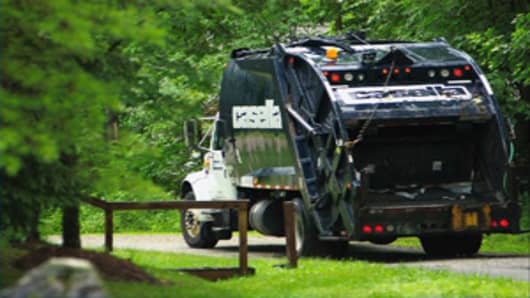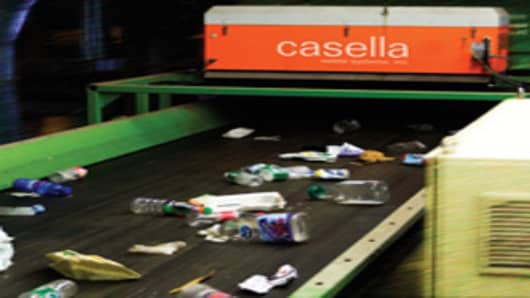When Casella Waste Systems jump-started recycling in Vermont 20 years ago it began by diverting cardboard from dumps. Last year it recycled 3.8 billion pounds - enough to fill the Empire State Building five times.
Along the way recycled trash became a commodity in ever greater demand.
“The economics of recycling don’t work unless there is a demand to turn it into something on the other end,” explains Casella’s Joe Fusco. “I remember 15-20 years ago the big news in newspaper recycling was that we could give it to farmers to use as bedding for cows.”
Nowadays, the company sells 400,000 tons of recycled paper a year – at more than $120 a ton – to a joint venture it has with LP, the building products firm formerly known as Louisiana Pacific, for insulation that is about 15 percent cheaper than fiberglass.
It is just one of a basket of commodities extracted from waste streams where there are attractive markets. More than 90 percent of the 15 million pounds of aluminum Casella extracts is now sold to Anheuser-Busch for $1,700 a ton.
Casella now derives 31 percent of its revenue from recycling - up from 18 percent in 2003. With $555 million in revenue in 2007, Casella is the country's 12th largest waste management firm, but Eric Prouty, equities analyst with Canaccord Adams, considers it among the most “forward looking” firms in the industry.
Transformation Underway
All of this is indicative of how the waste management industry is morphing into a “resource transformation” business, says CEO John Casella, who established Vermont’s first recycling plant in 1977, after starting out with a single truck in 1975.
The traditional waste disposal industry is in “the early stages of significant mindset and business model changes,” adds Prouty.
Increasingly, he says, garbage is being seen as a resource that can be monetized - rather than left as an environmental liability in landfills – and that despite recent progress the industry is still leaving plenty of money on the table.
Mention recycling and most people think of curbside collection programs for bottles, cans and newspapers, but make no mistake this has become big business.
It is a $71 billion industry employing more than 50,000 people, recycling more than 150 million tons of material that becomes raw feedstock material for manufacturing around the world.
It’s also growing quickly. “We are really seeing a convergence of a number of positive events, leading to a very robust period of growth,” says Matthew Coz, vice-president of business development for Waste Management Inc’s recycling unit, WM Recycle America.
Last year, the unit earned roughly $1 billion on company-wide revenue of $13 billion, by processing 7.8 million tons in 30 single stream material recovery facilities.
Commodities Factor
Two very different yet familiar forces are driving growth.
Strong demand from an increasingly resource-constrained world is driving up commodities prices.
More than 81 million tons of iron and steel were recycled last year. Two-thirds of the steel made in the U.S. is from ferrous scrap, about the same ratio that goes into making metal and alloys.
Concern about supply has recently triggered a wave of consolidation in the industry, as steel mills scramble to buy up scrap yards, according to Bruce Savage of the Institute of Scrap Recycling Industries, Inc, a trade association.
Another key factor are the high energy costs. For energy-intensive goods such as aluminum the savings can be as high as 95 percent. For paper, it is 64 percent. More than half of the country’s newsprint is now derived from scrap and a third of our aluminum.
The high cost of petroleum has even recently made recycling plastic profitable, which is beginning to lift stubbornly low recycling rates in this sector.
This dynamic has also boosted overseas demand, another reason recycling is an increasingly more attractive business.
Coz says export demand for recycled commodities has been growing at roughly 15 per year in recent years Scrap metal, for example, is the now the second most valuable export to China.
The volumes are significant: last year it contributed $21.7 billion to the US trade balance.
New Technology
Another growth driver is new technology, which “is changing the industry in pretty significant ways,” says Prouty.
Single stream collection systems allow high-tech conveyor belts to spit out clean piles of ‘market ready’ raw materials, separated in several different types of paper, glass or plastic, rather than the more cumbersome, less efficient, first generation dual stream systems.
The single stream systems are becoming more widely adopted and make it easier for the public to participate by giving them one, rather two or more bins, to fill.
Offering single stream tends to boost recycling up to 30 percent and businesses are increasingly demanding recycling services, says Coz.
That should boost national recycling rates, which the Environmental Protection Agency calculates at 34 percent but industry sources generally say it is really in the low 20s.
Significantly more money will flow into recycling if it is incorporated into evolving plans for a carbon cap-and-trade regime that all the presidential candidates support, says Casella, a board member of the National Recycling Coalition that is pushing for this.



